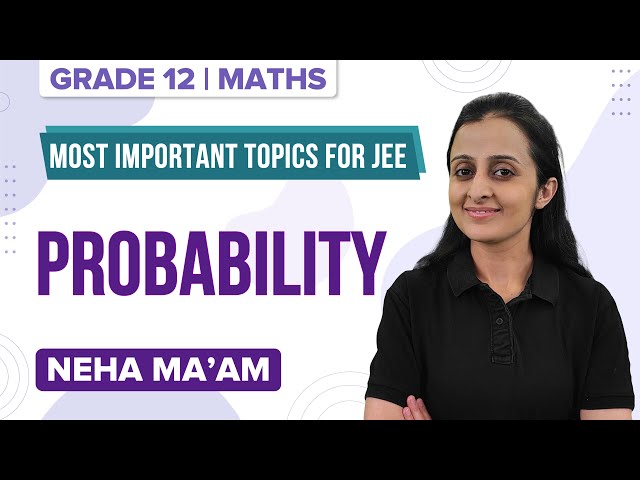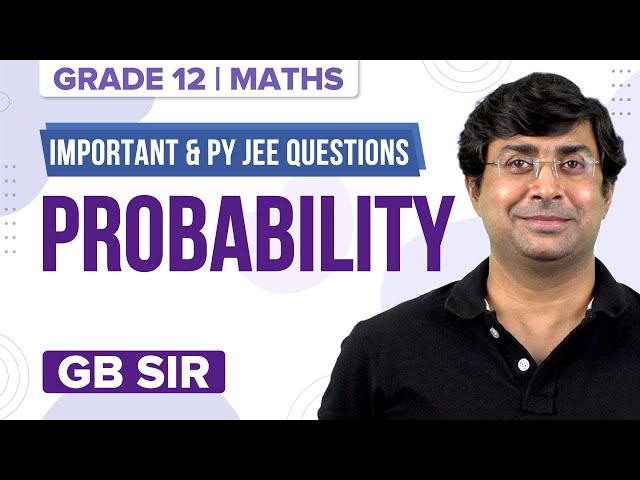Probability problems are very important for the JEE exams. Probability talks about the outcome of an experiment. When you toss a coin, the outcome will be either heads or tails. The probability of an outcome can be determined by dividing the number of times the outcome has occurred by the total number of events. This article explains the concept of probability and its numerical applications.
What Is Probability?
The chance of an event is called probability. Probability can be used to predict the event’s likeliness. It always lies between 0 and 1. Higher probability indicates a higher chance of occurrence of an event. The concept of probability can be used for events with a large number of outcomes and not restricted to less number of outcomes.
Formula to Find the Probability of an Event
Probability denotes the occurrence or non-occurrence of an event. The following formula is used to calculate the probability of an event.
Probability of event A = P(A) = (Number of outcomes favourable) / (Total number of outcomes)
Mutually exclusive events:
Two or more events associated with a random experiment are mutually exclusive if the occurrence of one prevents the occurrence of the other. Two or more events associated with a random experiment are mutually exclusive if there is no elementary event favourable to all events. Thus, if two events are mutually exclusive, then P(A ⋂ B) = 0
Likewise, if A, B, and C are mutually exclusive events, then P(A ⋂ B⋂ C) = 0.
Mutually exhaustive events:
Two or more events associated with a random experiment are mutually exhaustive if their union is the sample space, i.e., events A1, A2 .. An are associated with a random experiment with sample space S are exhaustive if A1 ⋃ A2 ⋃… An = S. All elementary events associated with a random experiment form a system of mutually exclusive and exhaustive events.
Important Points to Remember
1. If A and B are two events associated with a random experiment, then
P(A ⋃ B) = P(A) + P(B) – P(A ⋂ B)
2. If A and B are mutually exclusive events, then P(A ⋂B) = 0.
∴ P(A ⋃ B) = P(A) + P(B)
3. If A, B and C are three events associated with a random experiment, then
P(A ⋃ B ⋃ C) = P(A) + P(B) + P(C) – P(A⋂ B) – P(B⋂C) – P(A⋂C) + P(A⋂B⋂C)
If A, B and C are mutually exclusive events, then
P(A⋂ B) = P(B⋂C) = P(A⋂C) = P(A⋂B⋂C) = 0
∴ P(A ⋃ B ⋃ C) = P(A) + P(B) + P(C)
4. Let A and B be the two events associated with a random experiment, then
5. For any two events A and B, the probability that exactly one of A, B occurs is given by
P(A) + P(B) – 2 P(A ⋃ B) = P(A ⋃ B) – P(A ⋂ B)
6. If there are 3 events, A, B and C, then
P(At least two of A, B, C occur) = P(A ⋂ B) + P(B ⋂ C) + P(C ⋂ A) – 2 P(A ⋂ B ⋂ C)
P(Exactly two of A, B, C occur) = P(A ⋂ B) + P(B ⋂ C) + P(C ⋂ A) – 3 P(A ⋂ B ⋂ C)
P(Exactly one of A, B, C occur) = P(A) + P(B) + P(C) + P(A ⋂ B) – 2 P(A ⋂ B) – 2 P(B ⋂ C) – 2 P(A ⋂ C) + 3 P(A ⋂ B ⋂ C)
7. If A and B are independent events associated with a random experiment, then
P(A/B) = P(A) and P(B/A) = P(B)
If A and B are two events associated with a random experiment, then
P(A⋂B) = P(A) P(B/A) , if P(A) ≠ 0
Or P(A⋂B) = P(B) P(A/B) , if P(B) ≠ 0.
8. If A and B are independent events, then P(A/B) = P(A) and P(B/A) = P(B)
∴ P(A⋂B) = P(A) P(B)
Probability Most Important and Expected JEE Main Questions

Related Article:
Probability Problems Solved Examples
Example 1: A coin is tossed, and a die is rolled. What is the probability that the coin shows the head and the die shows 3?
Solution:
When a coin is tossed, the outcome is either a head or a tail. Similarly, when a die is rolled, the outcomes will be 1, 2, 3, 4, 5, 6.
Hence, the required probability = (1/2) (1/6) = 1/12.
Example 2: 8 nails and 12 nuts are present in a box. Among them, half the nails and half the nuts are rusted. If an item is chosen at random, what is the probability that it is rusted or is a nail?
Solution:
Total rusted items = 4 + 6 = 10
Unrusted nails = 4.
Required probability = 4 + (10/8) + 12 = 14/20 = 7/10.
Example 3: The probability of happening event A in one trial is 0.5. What is the probability that event A happens at least once in three independent trials?
Solution:
Here, P(A)=0.5 and
The probability that A does not happen at all = (0.5)3
Thus, the required probability = 1 – (0.5)3 = 0.875
Example 4: A man and a woman appear in an interview for two vacancies for the same post. The probability of the man’s selection is 1/3, and that of the woman’s selection is 1/2. What is the probability that neither of them will be selected?
Solution:
Let E1 be the event that the man will be selected and E2 the event that the woman will be selected.
Then P(E1)= 1/3 so
P(E2) = 1/2
So,
Clearly, E1 and E2 are independent events.
So,
= (2/3) × (1/2)
= 1/3
Example 5: Three dice are thrown simultaneously. What is the probability of obtaining a total of 17 or 18?
Solution:
Three dice can be thrown in 6 × 6 × 6 = 216 ways.
A total of 17 can be obtained as (5, 6, 6), (6, 5, 6), (6, 6, 5).
A total of 18 can be obtained as (6, 6, 6).
Hence, the required probability = 4/216 = 1/54.
Example 6: What is the number of times a coin needs to be tossed in order to get at least once a head with probability ≥0.9?
Solution:
Probability of getting at least one head in n tosses
⇒ 1 − (1/2)n ≥ 0.9
⇒(1/2)n ≤ 0.1
⇒ 2n ≥ 10
⇒ n ≥ 3
Hence, the least value of n = 4.
Example 7: The three ships namely A, B, and C, sail from India to Africa. If the ratio of the ships reaching safely is 2: 5, 3: 7 and 6: 11, then find the probability of all of them arriving safely.
Solution:
The ratio of the ships A, B and C for arriving safely are 2: 5, 3: 7 and 6: 11, respectively.
The probability of ship A for arriving safely = 2 / [2 + 5] = 2 / 7
Similarly, for B = 3 / [3 + 7] = 3 / 10 and for C = 6 / [6 + 11] = 6 / 17
∴ The probability of all the ships arriving safely = [2 / 7] × [3 / 10] × [6 / 17] = [18 / 595].
Example 8: If A and B are two events such that P (A) = 0.4 , P (A + B) = 0.7 and P (AB) = 0.2, then P (B) =
Solution:
Since we have P (A + B) = P (A) + P (B) − P (AB)
⇒ 0.7 = 0.4 + P (B) − 0.2
⇒ P (B) = 0.5.
Example 9: If A and B are two independent events such that
then find P(A).
Solution:
Since events are independent,
Similarly,
On solving (i) and (ii), we get;
Example 10: Consider two events, A and B, to be independent. The probability of occurrence of both events A and B is 1/6, and the probability that neither of them occurs is 1/3. Then, find the probability of the two events.
Solution:
Example 11: There are 3 bags which are known to contain 2 white and 3 black balls, 4 white and 1 black ball and 3 white and 7 black balls, respectively. A ball is drawn at random from one of the bags and found to be a black ball. Then, the probability that it was drawn from the bag containing the maximum black balls is
Solution:
Consider the following events:
A → Ball drawn is black
E1→ Bag I is chosen
E2→ Bag II is chosen
E3→ Bag III is chosen
Then
Probability Previous Year JEE Questions

Probability – JEE Advanced Questions

Probability – Important Topics

Probability – Important Questions

Frequently Asked Questions
A coin is thrown twice. What is the probability that at least one head is obtained?
Let A be the event of getting at least one head.
Sample space = {HH, HT, TT, TH}
Total number of outcomes = 4
The number of favourable outcomes = 3
The probability that at least one head is obtained, P(A) = number of favourable outcomes/total number of outcomes
= 3/4
Hence, the required probability = 3/4.
Find the probability of getting a prime number when a die is rolled once.
Let A be the event of getting a prime number.
Sample space = {1, 2, 3, 4, 5, 6}
Total number of outcomes = 6
Prime numbers are 2, 3 and 5.
Number of favourable outcomes = 3
The probability of getting a prime number, P(A) = number of favourable outcomes/total number of outcomes = 3/6 = 1/2
Hence, the required probability = 1/2.
A card is drawn at random from a pack of 52 cards. Find the probability that the card is a king.
Total number of cards = 52
Number of kings = 4
Required probability = number of favourable outcomes/total number of outcomes
= 4/52
= 1/13.

Comments